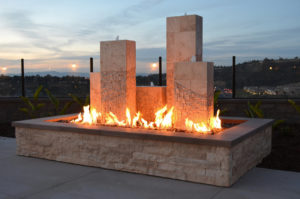Whether you’re thinking about a backyard patio, a walkway to your front door, or another outdoor area, the floor material for your project will affect how you can use the space, how long it lasts, and how much you enjoy it. In some cases, deciding between outdoor tile and pavers is a personal preference about style. However, the differences between outdoor tile and pavers can make one material better suited to certain projects.
Is outdoor tile or pavers the best choice for you? Here’s what you need to know about the different types of flooring and how choosing outdoor tile or pavers can affect your results.
Outdoor Tile vs. Pavers: What Are the Material and Surface Differences?
The difference between outdoor tile and pavers starts with the material itself.
Outdoor tile has a more refined look. It’s a thinner material that has more precise cuts and shaping, and tile manufacturing usually involves surface treatments such as glazing or polishing. There is a wide range of design choices from natural-looking tile to high-gloss or formal designs.

Tile can be cast from porcelain or clay. These cast tiles usually have a surface coating that makes them durable, resistant to water, and impervious to weather. Outdoor tile can also be glazed in different colors or patterns, and realistic surface treatments can create the look of marble or wood, even though the tile is made from ceramic or porcelain.
Outdoor tile can also be cut from stone, and materials like slate, granite, marble and bluestone are commonly used to create natural stone tile.
Pavers, or paving stones, are usually made from concrete, brick or natural stone. The surface texture is usually rough and porous. They’re thicker, usually 3/4″ or more, compared to the fraction of an inch of a typical tile.
Pavers come in a range of colors, shapes and sizes, but there isn’t as much style variety as with tile. Also, pavers with an unfinished surface can fade over time from sun exposure and weather.
There is some overlap between the two categories. For example, cast cement tile has the material body of pavers with the surface finish of tile. Some of these products can be used outdoors, but they generally can’t withstand freezing temperatures and should only be considered in warmer climates. And their thickness and weight mean they’re rarely used indoors.
Some outdoor pavers are designed to look like tile. These porcelain pavers can give you the best of both worlds, combining the design options of tile with the usage of traditional pavers.

Outdoor Tile vs. Pavers: How Does Installation and Permanence Compare?
Outdoor tile and pavers have different installation methods, and as a result, they have different levels of permanence.
Outdoor tile is a more permanent outdoor flooring. The installation process usually starts with pouring a concrete slab, or homeowners can use an existing patio block or another flooring substrate. Installers spread adhesive, put down the tile, add grout, and seal the finished product. After installation, rearranging the tile is not an option.
The permanence of outdoor tile gives you a surface that’s easy to clean and maintain, and it creates flooring that you can enjoy for years. Some historic buildings have outdoor porcelain tile installations that have been in place for centuries.
Pavers still require an installation process, but the process usually involves dry-setting without adhesive. This can give you a little more flexibility if you want to update your landscaping.
Paver installation starts with digging a few inches below grade, creating a level base with sand, setting the pavers, and using a perimeter rail to hold together patios or walkways. Grout is generally not used for pavers, but polymeric sand is a popular way to bind pavers together and help stop weeds from growing in your patio.
Outdoor Tile vs. Pavers: What Are the Design and Usage Differences?
Your site and usage may help determine if pavers or outdoor tile is right for your project.
Outdoor tile can create a finished look that’s a perfect choice for outdoor dining areas, patios or near pools. Using tile in areas next to the house can make it feel like outdoor spaces are an expansion of indoor living spaces. Reasons to use outdoor tile include everything from adding style to reducing home maintenance.

Outdoor tile is extremely durable, and manufacturer recommendations can help you choose the best flooring for concerns like slip resistance near pools or freeze resistance for cold climates. Although outdoor tile is used for high-traffic areas, it’s not suited for heavy loads such as driveways.
Pavers, on the other hand, can be tough enough to withstand heavy lawn equipment or light vehicle traffic on a driveway. Pavers will remain structurally strong, but unsealed concrete pavers can become weathered over time. Professional installers generally recommend that homeowners choose slightly darker concrete or brick to account for the color fading that happens.
Traditional pavers offer fewer design options. Even with the wide variety of patterns, colors and textures that are now available, you won’t find the same range of styles as with tile.
What’s the Best Flooring For Your Outdoor Project?
When deciding what floor material to use, consider how you plan to use the space, how long you want it to last, and what you want it to look like. Get inspired with this gallery of outdoor floor tile and immerse yourself in this virtual showroom that lets you tour different uses of outdoor tile and pavers.










You have shared A very useful piece of information. The knowledge that I have gathered through your blog is commendable. Keep sharing such blogs in the future too. Thanks!
Thank you so much for the feedback!